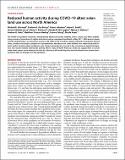Files in this item
Reduced human activity during COVID-19 alters avian land use across North America
Item metadata
| dc.contributor.author | Schrimpf, Michael B. | |
| dc.contributor.author | Des Brisay, Paulson G. | |
| dc.contributor.author | Johnston, Alison | |
| dc.contributor.author | Smith, Adam C. | |
| dc.contributor.author | Sanchez-Jasso, Jessica | |
| dc.contributor.author | Robinson, Barry G. | |
| dc.contributor.author | Warrington, Miyako H. | |
| dc.contributor.author | Mahony, Nancy A. | |
| dc.contributor.author | Horn, Andrew G. | |
| dc.contributor.author | Strimas-Mackey, Matthew | |
| dc.contributor.author | Fahrig, Lenore | |
| dc.contributor.author | Koper, Nicola | |
| dc.date.accessioned | 2021-11-23T15:30:02Z | |
| dc.date.available | 2021-11-23T15:30:02Z | |
| dc.date.issued | 2021-09-22 | |
| dc.identifier | 276796539 | |
| dc.identifier | e7c61f7d-a979-440d-bb49-a3b1176e1121 | |
| dc.identifier | 000699973200004 | |
| dc.identifier | 85115892369 | |
| dc.identifier.citation | Schrimpf , M B , Des Brisay , P G , Johnston , A , Smith , A C , Sanchez-Jasso , J , Robinson , B G , Warrington , M H , Mahony , N A , Horn , A G , Strimas-Mackey , M , Fahrig , L & Koper , N 2021 , ' Reduced human activity during COVID-19 alters avian land use across North America ' , Science Advances , vol. 7 , no. 39 , 5073 . https://doi.org/10.1126/sciadv.abf5073 | en |
| dc.identifier.issn | 2375-2548 | |
| dc.identifier.other | ORCID: /0000-0001-8221-013X/work/103865998 | |
| dc.identifier.uri | https://hdl.handle.net/10023/24386 | |
| dc.description | Funding: Natural Sciences and Engineering Research Council of Canada Alliance COVID-19 grant ALLRP 550721-20. In-kind support was provided by Environment and Climate Change Canada and Cornell Lab of Ornithology. | en |
| dc.description.abstract | The COVID-19 pandemic resulted in extraordinary declines in human mobility, which, in turn, may affect wildlife. Using records of more than 4.3 million birds observed by volunteers from March to May 2017-2020 across Canada and the United States, we found that counts of 66 (80%) of 82 focal bird species changed in pandemic-altered areas, usually increasing in comparison to prepandemic abundances in urban habitat, near major roads and airports, and in counties where lockdowns were more pronounced or occurred at the same time as peak bird migration. Our results indicate that human activity affects many of North America's birds and suggest that we could make urban spaces more attractive to birds by reducing traffic and mitigating the disturbance from human transportation after we emerge from the pandemic. | |
| dc.format.extent | 11 | |
| dc.format.extent | 3278332 | |
| dc.language.iso | eng | |
| dc.relation.ispartof | Science Advances | en |
| dc.subject | GE Environmental Sciences | en |
| dc.subject | QA Mathematics | en |
| dc.subject | QH301 Biology | en |
| dc.subject | DAS | en |
| dc.subject | SDG 11 - Sustainable Cities and Communities | en |
| dc.subject | SDG 15 - Life on Land | en |
| dc.subject.lcc | GE | en |
| dc.subject.lcc | QA | en |
| dc.subject.lcc | QH301 | en |
| dc.title | Reduced human activity during COVID-19 alters avian land use across North America | en |
| dc.type | Journal article | en |
| dc.contributor.institution | University of St Andrews. Statistics | en |
| dc.contributor.institution | University of St Andrews. Centre for Research into Ecological & Environmental Modelling | en |
| dc.identifier.doi | 10.1126/sciadv.abf5073 | |
| dc.description.status | Peer reviewed | en |
This item appears in the following Collection(s)
Items in the St Andrews Research Repository are protected by copyright, with all rights reserved, unless otherwise indicated.

